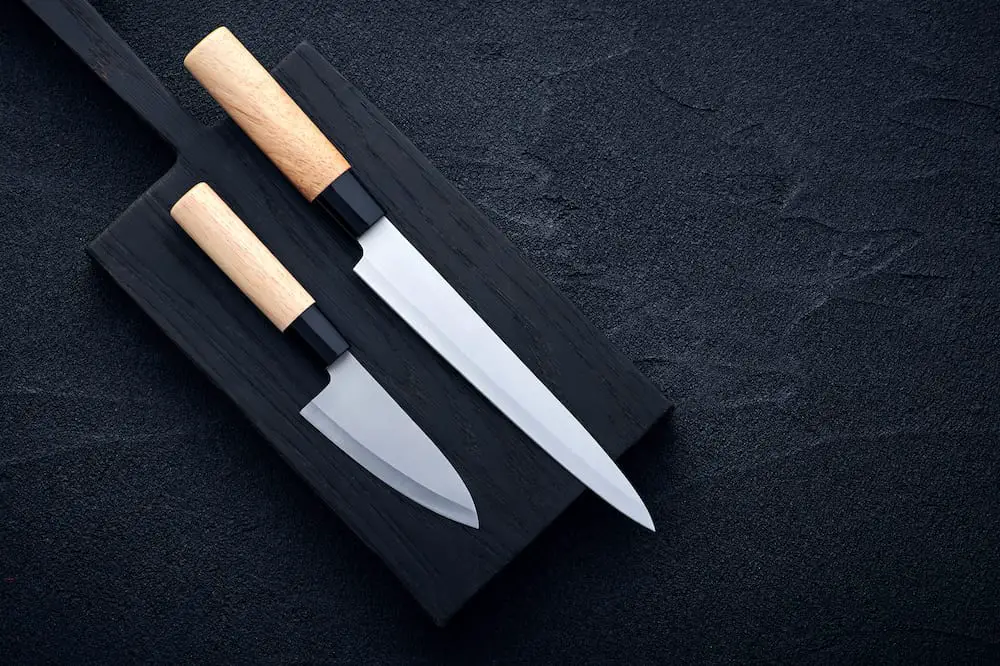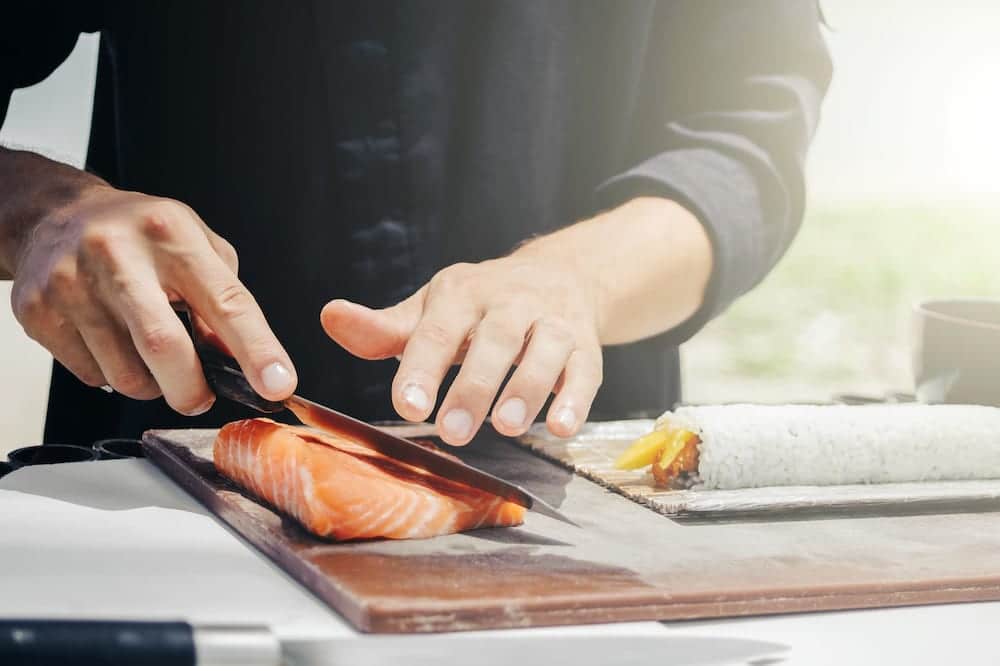Japanese fillet knives are vital kitchen tools for those who love to prepare fish dishes. The Japanese craftsmen’s ingenuity in creating these premium products provide us with razor-sharp and durable fillet knives that last for a long time.
Fillet knives are part of the boning knife family. This flexible knife helps and provides control when filleting a fish.
These heavy knives have sharp and thick blades which are perfect for filleting a fish. Fillet knife blades generally measure 15 to 28 centimeters long which makes it easy to move the edge under the skin and along the backbone.
Japanese Fillet Knives: What Are They
Japanese fillet knives are usually called Deba, which are single beveled knives sharpened on one side at different angles depending on how you intend to use them. They are specifically designed to ideally separate the flesh of the fish from its bones and skin.
Most conventional fillet knives use carbon steel for their blades which need constant oiling and maintenance to avoid rusting. However, there are modern fillet knives made of stainless steel, and they are easier to maintain.
Blades usually measure from 150 mm to 280 mm. These differences affect the texture and consistency of your fillet.
Knives created by Japanese blacksmiths have the ideal size and shape that’s perfect for fish meal preparation. The blades are perfectly angled, which makes them sharper, giving you precise and clean fillet cuts. You will find different designs with their distinct characteristics like the shape of the blade, the thickness, flexibility, and grind.

Different Japanese Knives and Their Uses
Some do not have any idea what Japanese knives are and what makes them different and superior from other kitchen knives. Below are some of the most common Japanese knife varieties and their uses.
Gyutou or Chef’s Knife
Gyutou is the Japanese counterpart of the Western or European chef’s knife. This knife is considered the all-around tool used for almost all kinds of meal preparation.
The Japanese chef’s knife is thinner and lighter than its counterpart. The hard steel used to create this knife gives it a superior edge.
Santoku or Multipurpose Knife
Santoku means three virtues in Japanese. It’s also an all-purpose knife like the gyutou knife but with a taller blade. It can cut fish, vegetables, and meat.
This knife is flatter than gyutou and more comfortable to use with a chopping motion.
Sujihiki or Slicer
Sujihiki knives are much like the slicer in the European category but with few distinctions from its equivalent. Sujihiki knife blades are made using harder steel, which helps in keeping the edge better and long-lasting.
Also, honing the slant on the knife at a higher angle offers a more accurate cut. This knife is typically used for filleting and carving but also appropriate for everyday use.
Petty or Paring Knife
Petty or paring knives are small, so they’re perfect for delicate cutting that other knives cannot handle like cutting small fruits, vegetables, and herbs.
Honesuki or Boning Knife
Honesuki is the Japanese version of a boning knife. It is different from its Western counterpart because of its triangular shape and a solid blade with little flexibility. Its primary purpose is to cut through soft joints and to debone poultry products.
Hankotsu or Boning Knife
Hankotsu is another version of a Japanese boning knife. Its shape is still different from the Western version. It has a sturdy blade and a thick spine with no flexibility compared to the Western boning knife.
This knife is used in deboning hanging meats and cleaning loins but may also be used as a utility knife if needed.
Nakiri or Vegetable Knife
Nakiri knives have straight blades which are perfect for precise vegetable cuts. It is also perfect for cutting into hard-skinned vegetables like squash and pumpkin.
Yo-Deba or Butchery Knife
These are heavy and sturdy knives with a thick spine. They are generally used for meat and fish butchery. This knife is appropriate for both left- and right-handed users.
Yanagi or Slicer Knife
These are single-edged, conventional Japanese knives that are very sharp. They are used to cut perfect slices of sushi, sashimi, and crudo.
Deba or Butchery Knife
This single beveled conventional Japanese knife has a thick spine and carries a lot of weight. It is suitable for filleting, fish butchering, and poultry meat slicing. It has different sizes depending on the size of the fish or meat.
Kiritsuke or Slicer
This is an old Japanese knife with a diagonal tip used as a Sashimi knife. In Japan restaurants, the executive chef is the only person allowed to use this knife.
Pankiri or Bread Knife
Pankiri is the Japanese version of the bread knife used to cut baked goods. The ridged teeth can cut through delicate pieces of bread and hard crusts without any sign of damage.
How to Maintain Japanese Fillet Knives
A Japanese fillet knife is the number one choice when it comes to filleting a fish because it can take care of the whole fish filleting process, from slicing through the bone to getting accurate slices. However, they can only do their job if you take care of them well. Also, just like any other item, you need to take care of your fillet knives for it to last.
To do so, here are things to keep in mind:
- You should not put your knife in the dishwater. Hand wash it with mild soap and dry thoroughly using a paper towel before storing it.
- Do not use your knife to cut through bones, frozen food, and thick items.
- Do not twist the blade and always cut with a flowing motion.
- Make sure that you only use Japanese Water stones in honing your knife.
- Immediately remove any signs of rust on the blade to prevent it from spreading.
- Store your knife in its original box, or you can use a knife block or knife magnet to make sure that there is no moisture left on the blade.
Conclusion
Whether you are a professional chef or a home cook, investing in a high-quality kitchen knife is a necessity. Whatever meal preparation you are making will be completed quicker using a top-quality kitchen tool. Just remember all the maintenance tips we have provided so that your kitchen knives last longer.


